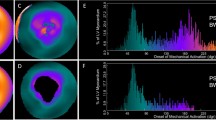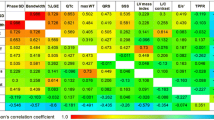Abstract
Objectives
Cardiac resynchronization therapy (CRT) is the established treatment for patients with chronic and severe heart failure, and it has been reported that the presence of left ventricular (LV) dyssynchrony is one of the most important factors which predict positive response of this therapy. In the present study, we developed new software algorithm for quantitative assessment of LV dyssynchrony from ECG-gated myocardial perfusion SPECT (GMPS), and evaluated its utility for the management of CRT.
Methods
Thirty-three patients with chronic severe heart failure were studied. GMPS was performed with 16 frame per-cardiac-cycle before and 6 months after CRT and LV end-diastolic volume, end-systolic volume (LVESV), ejection fraction (LVEF) were calculated by QGS software. We generated the time–activity curve per-cardiac-cycle in 4 myocardial segments by Fourier transform curve-fitting of the 16 serial count values, and measured the time from R-wave to the maximum-count point [time to end-systole (TES)] in each. For the evaluation of the degree of LV dyssynchrony, we used the maximum difference in TES (ΔTES) among the 4 segments which corrected for R–R time as dyssynchrony index (DI). Moreover, DI at baseline evaluated by GMPS was compared with the echocardiographic index of LV dyssynchrony; maximum difference of time to peak velocity (ΔTPV) evaluated by tissue Doppler imaging (TDI).
Results
DI before CRT showed a significant correlation with the LV function, such as LVEF, LVESV (DI vs. LVEF; r = 0.57, P < 0.0001. DI vs. LVESV; r = 0.64, P < 0.0001). The study subjects were divided into 2 groups, responder group (R-Gp) with LVEF increase >10% or LVESV decrease >10% and non-responder group (NR-Gp). DI before CRT was significantly larger in R-Gp than in NR-Gp (25.9 ± 22.2 vs. 10.8 ± 8.9, P = 0.01). In R-Gp, DI showed a significant decrease after CRT (25.9 ± 22.2 → 13.6 ± 10.9, P < 0.05). DI at baseline measured by GMPS correlated significantly with ΔTPV at baseline measured by TDI (r = 0.38, P < 0.05).
Conclusions
This new algorithm for the estimation of LV dyssynchrony might be comparable to TDI, and contributes to the prediction and the evaluation for the response of CRT.








Similar content being viewed by others
References
Abraham WT, Fisher WG, Smith AL, Delurgio DB, Leon AR, Loh E, et al. Cardiac resynchronization in chronic heart failure. N Engl J Med. 2002;346(24):1845–53.
Bristow MR, Saxon LA, Boehmer J, Krueger S, Kass DA, De Marco T, et al. Cardiac-resynchronization therapy with or without an implantable defibrillator in advanced chronic heart failure. N Engl J Med. 2004;350(21):2140–50.
Cleland JG, Daubert JC, Erdmann E, Freemantle N, Gras D, Kappenberger L, et al. The effect of cardiac resynchronization on morbidity and mortality in heart failure. N Engl J Med. 2005;352(15):1539–49.
St John Sutton MG, Plappert T, Abraham WT, Smith AL, DeLurgio DB, Leon AR, et al. Effect of cardiac resynchronization therapy on left ventricular size and function in chronic heart failure. Circulation. 2003;107(15):1985–90.
Gregoratos G, Abrams J, Epstein AE, Freedman RA, Hayes DL, Hlatky MA, et al. ACC/AHA/NASPE 2002 Guideline update for implantation of cardiac pacemakers and antiarrhythmia devices—summary article: a report of the American College of Cardiology/American Heart Association Task Force on Practice Guidelines (ACC/AHA/NASPE Committee to update the 1998 Pacemaker Guidelines). J Am Coll Cardiol. 2002;40(9):1703–19.
Hunt SA, Abraham WT, Chin MH, Feldman AM, Francis GS, Ganiats TG, et al. ACC/AHA 2005 Guideline update for the diagnosis and management of chronic heart failure in the adult: a report of the American College of Cardiology/American Heart Association Task Force on practice guidelines (Writing Committee to update the 2001 guidelines for the evaluation and management of heart failure): developed in collaboration with the American College of Chest Physicians and the International Society for Heart and Lung Transplantation: endorsed by the Heart Rhythm Society. Circulation. 2005;112(12):e154–235.
Bax JJ, Abraham T, Barold SS, Breithardt OA, Fung JW, Garrigue S, et al. Cardiac resynchronization therapy: part 1—issues before device implantation. J Am Coll Cardiol. 2005;46(12):2153–67.
Bax JJ, Bleeker GB, Marwick TH, Molhoek SG, Boersma E, Steendijk P, et al. Left ventricular dyssynchrony predicts response and prognosis after cardiac resynchronization therapy. J Am Coll Cardiol. 2004;44(9):1834–40.
Yu CM, Fung JW, Zhang Q, Chan CK, Chan YS, Lin H, et al. Tissue Doppler imaging is superior to strain rate imaging and postsystolic shortening on the prediction of reverse remodeling in both ischemic and nonischemic heart failure after cardiac resynchronization therapy. Circulation. 2004;110(1):66–73.
Faber TL, Cooke CD, Folks RD, Vansant JP, Nichols KJ, DePuey EG, et al. Left ventricular function and perfusion from gated SPECT perfusion images: an integrated method. J Nucl Med. 1999;40(4):650–9.
Fukuchi K, Uehara T, Morozumi T, Tsujimura E, Hasegawa S, Yutani K, et al. Quantification of systolic count increase in technetium-99m-MIBI gated myocardial SPECT. J Nucl Med. 1997;38(7):1067–73.
Smith WH, Kastner RJ, Calnon DA, Segalla D, Beller GA, Watson DD. Quantitative gated single photon emission computed tomography imaging: a counts-based method for display and measurement of regional and global ventricular systolic function. J Nucl Cardiol. 1997;4(6):451–63.
Stollfuss JC, Haas F, Matsunari I, Neverve J, Nekolla S, Schneider-Eicke J, et al. Regional myocardial wall thickening and global ejection fraction in patients with low angiographic left ventricular ejection fraction assessed by visual and quantitative resting ECG-gated 99mTc-tetrofosmin single-photon emission tomography and magnetic resonance imaging. Eur J Nucl Med. 1998;25(5):522–30.
Chen J, Henneman MM, Trimble MA, Bax JJ, Borges-Neto S, Iskandrian AE, et al. Assessment of left ventricular mechanical dyssynchrony by phase analysis of ECG-gated SPECT myocardial perfusion imaging. J Nucl Cardiol. 2008;15(1):127–36.
Henneman MM, Chen J, Ypenburg C, Dibbets P, Bleeker GB, Boersma E, et al. Phase analysis of gated myocardial perfusion single-photon emission computed tomography compared with tissue Doppler imaging for the assessment of left ventricular dyssynchrony. J Am Coll Cardiol. 2007;49(16):1708–14.
Henneman MM, Chen J, Dibbets-Schneider P, Stokkel MP, Bleeker GB, Ypenburg C, et al. Can LV dyssynchrony as assessed with phase analysis on gated myocardial perfusion SPECT predict response to CRT? J Nucl Med. 2007;48(7):1104–11.
Germano G, Erel J, Lewin H, Kavanagh PB, Berman DS. Automatic quantitation of regional myocardial wall motion and thickening from gated technetium-99m sestamibi myocardial perfusion single-photon emission computed tomography. J Am Coll Cardiol. 1997;30(5):1360–7.
Germano G, Kiat H, Kavanagh PB, Moriel M, Mazzanti M, Su HT, et al. Automatic quantification of ejection fraction from gated myocardial perfusion SPECT. J Nucl Med. 1995;36(11):2138–47.
Ypenburg C, Schalij MJ, Bleeker GB, Steendijk P, Boersma E, Dibbets-Schneider P, et al. Extent of viability to predict response to cardiac resynchronization therapy in ischemic heart failure patients. J Nucl Med. 2006;47(10):1565–70.
Chung ES, Leon AR, Tavazzi L, Sun JP, Nihoyannopoulos P, Merlino J, et al. Results of the Predictors of Response to CRT (PROSPECT) trial. Circulation. 2008;117(20):2608–16.
Cooke CD, Garcia EV, Cullom SJ, Faber TL, Pettigrew RI. Determining the accuracy of calculating systolic wall thickening using a fast Fourier transform approximation: a simulation study based on canine and patient data. J Nucl Med. 1994;35(7):1185–92.
Chen J, Garcia EV, Folks RD, Cooke CD, Faber TL, Tauxe EL, et al. Onset of left ventricular mechanical contraction as determined by phase analysis of ECG-gated myocardial perfusion SPECT imaging: development of a diagnostic tool for assessment of cardiac mechanical dyssynchrony. J Nucl Cardiol. 2005;12(6):687–95.
Yamamoto A, Hosoya T, Takahashi N, Iwahara S, Munakata K. Quantification of left ventricular regional functions using ECG-gated myocardial perfusion SPECT—validation of left ventricular systolic functions. Ann Nucl Med. 2006;20(7):449–56.
Yamamoto A, Takahashi N, Munakata K, Hosoya T, Shiiba M, Okuyama T, et al. Global and regional evaluation of systolic and diastolic left ventricular temporal parameters using a novel program for ECG-gated myocardial perfusion SPECT—validation by comparison with gated equilibrium radionuclide angiography and speckle-tracking radial strain from echocardiography. Ann Nucl Med. 2007;21(2):115–21.
Keida T, Ohira H, Fujita M, Chinen T, Nakamura K, Kato T, et al. Quantitative assessment of dyssynchrony using ECG-gated SPECT myocardial perfusion imaging prior to and following cardiac resynchronization therapy. Circ J Off J Jpn Circ Soc. 2009;73(8):1550–3.
Morishima I, Sone T, Tsuboi H, Mukawa H, Uesugi M, Hayashi K. Demonstration of left ventricular dyssynchrony and resynchrony by ECG-gated SPECT with cardioGRAF in a patient with advanced heart failure and narrow QRS complex. J Interv Card Electrophysiol. 2009;24(2):151–4.
Author information
Authors and Affiliations
Corresponding author
Rights and permissions
About this article
Cite this article
Kiso, K., Imoto, A., Nishimura, Y. et al. Novel algorithm for quantitative assessment of left ventricular dyssynchrony with ECG-gated myocardial perfusion SPECT: useful technique for management of cardiac resynchronization therapy. Ann Nucl Med 25, 768–776 (2011). https://doi.org/10.1007/s12149-011-0525-8
Received:
Accepted:
Published:
Issue Date:
DOI: https://doi.org/10.1007/s12149-011-0525-8




